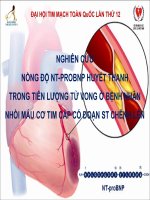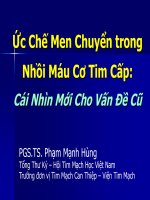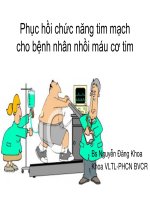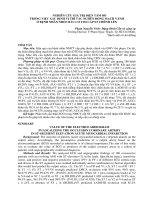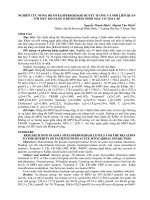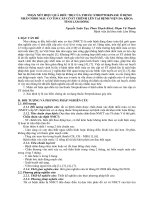Vai trò của ICD ở người bệnh sau nhồi máu cơ tim
Bạn đang xem bản rút gọn của tài liệu. Xem và tải ngay bản đầy đủ của tài liệu tại đây (10.55 MB, 35 trang )
Role Of ICD Post-MI Patients
With Heart Failure
Anil Saxena
Director & Clinical Head
Cardiac Pacing & Electrophysiology
Fortis Escorts Heart Institute, New Delhi INDIA
VT After MI: Anatomy of Scar
Underlying Arrhythmia of Sudden Death
Primary
VF
8%
Torsades
de Pointes
13%
VT
Bradycardia
62%
Adapted from Bayés de Luna A. Am Heart J. 1989;117:151-159.
17%
Sudden Cardiac Death
Sudden Cardiac Death
The Chain Of Survival
Time to Defibrillation
• Recognize cardiac arrest
• Activate emergency response
• Call hospital / ambulance
• Medical help arrives on scene
• Locate victim and shock
• Total Elapsed Time
1 min
1 min
1 min
10 min
2 min
15 min
ICD: Placement
Implantable Cardioverter
Defibrillator
MADIT II Trial Design
Documented
Prior MI
Selection
LVEF <30%
Consent &
Randomisation
•
Enrolment
No ICD
ICD
Follow-up
@ 3 months
Monitor Rx
End Points
Follow-up
•
Status: Completed in 2001
First trial to show the life-saving
benefits of ICDs without
requiring patients to have a
documented history of abnormal
heart rhythms
Results
Mortality over an average follow-up of 20 months
31% reduction in the risk of death at
any interval among patients in the
defibrillator group as compared with
patients in the conventional-therapy group
The cumulative survival curves represent
a decrease in death rates in the defibrillator
group (95% confidence limits; P-value) of
12% at 1 year (27 to 40%), 28% at 2 years (4
to 46%), and 29% at 3 years (5 to 46%).
Additional Results – MADIT II 8-Year Data
Mortality over an average of 7.6 years* post-enrollment
Cumulative Probability of Mortality (n=1232)
ICD
No ICD (Conventional Therapy)
49%
62%
• 34% relative reduction in the
risk of death at any interval among
patients with a defibrillator as
compared with patients without an
ICD
• Number needed to treat (NNT)
• 8 at 8 years
• 17 at 2 years
• Analysis showed sustained benefit
with primary ICD therapy in the
MADIT II study population
*median
Circ 2010; 122: 1265-1271
Hazard Ratio (95% CI)
p-value
0.66 (0.56-0.78)
<0.001
Indications for ICD Therapy
Class I (Post MI)
• ICD therapy is indicated in patients with previous
MI and spontaneous sustained VT, whether
hemodynamically stable or unstable
(Level of Evidence: A)
❖
Prior MI
❖
Spontaneous sustained VT
❖
Hemodynamically stable or unstable
Indications for ICD Therapy
Class I (Post MI)
• ICD therapy is recommended for patients with prior
MI who are at least 40 days post-MI, have an LVEF
less than 35%, are NYHA functional class II or III.
(Level of Evidence: A)
❖
Prior MI, at least 40 days post MI
❖
LVEF <35%
❖
NYHA functional class II or III
Indications for ICD Therapy
Class I (Post MI)
• ICD therapy is recommended for patients with
prior MI who are at least 40 days post-MI, have an
LVEF less than 30%, are NYHA functional class I
(Level of Evidence: A)
❖
Prior MI, at least 40 days post MI
❖
LVEF <30%
❖
NYHA functional class I
Indications for ICD Therapy
Class I (Post MI)
• ICD therapy is indicated in patients with
nonsustained VT due to prior MI, LVEF less than or
equal to 40%, and inducible VF or sustained VT at
electrophysiological study
(Level of evidence B)
❖
Prior MI, Non-sustained VT
❖
LVEF <40%
❖
Inducible VF or sustained VT on EP study
Indications for ICD Therapy
Class I (Post MI)
• ICD therapy is indicated in patients with syncope of
undetermined origin with clinically relevant,
hemodynamically significant sustained VT or VF
induced at electrophysiological study
(Level of Evidence: B)
❖
Prior MI, history of syncope
❖
LVEF - Any EF
❖
Hemodynamically unstable VT on EP study
What Changes Could Be Done?
• More inclusions by identifying clinical situations
which cause SCD risk
❖
Less than 40 day Post MI patients with low EF
• Less liberal guidelines by better risk stratification
❖
Primary prevention population (some may not be
benefitting)
Case
• 54 year male presents with acute anterior MI
• Has sustained VT at 36 hours, DC shock given
• Revascularization NOT done/possible/available
• LVEF 25%
Secondary Prevention: CAD—VF or Hemodynamically
Unstable VT Associated With Acute (<48 h) MI
Single or Recurrent VF or
Polymorphic VT With Acute
(<48 Hours) MI
Total
revascularization
completed
No revascularization
indicated
Not amenable to
revascularization


